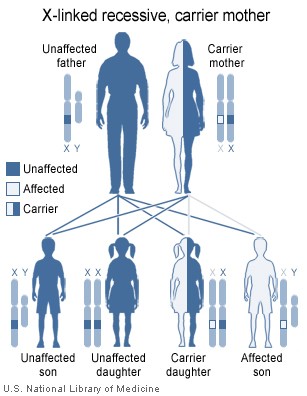X-linked recessive is a mode of inheritance in which a mutation in a gene on the X chromosome causes the phenotype to be expressed only (1) in males (who are necessarily hemizygous for the gene mutation because they have only one X chromosome) and (2) in females who are homozygous for the gene mutation (i.e., they have a copy of the gene mutation on each of their two X chromosomes).

X-linked inheritance means that the gene causing the trait or the disorder is located on the X chromosome. Females have two X chromosomes, while males have one X and one Y chromosome. Carrier females who have only one copy of the mutation do not usually express the phenotype, although differences in X chromosome inactivation can lead to varying degrees of clinical expression in carrier females.
Sex Differences In Phenotype
In humans, generally "men are affected and women are carriers" for two reasons. The first is the simple statistical fact that if 1% (1 in 100) of all X-chromosomes carry an X-linked mutation and then 1 in 100 men (1% of them) are likely to express the mutation while 1 in 10,000 women (0.01% of them) are likely to. Thus, X-linked mutations tend to be rare in women. The second reason for female rarity is that women who express the mutation must have two X chromosomes that carry the trait and they necessarily got one from their father... who would have also expressed the trait because he only had one X chromosome in the first place (that's why he was male). If the trait lowers the probability of fathering a child or induces the father to only have children with women who aren't carriers (so as not to create daughters who are carriers rather than expressers and then only if no genetic screening is used) then women become even less likely to express the trait than the statistical prediction of 0.01%. (Note that the percentages are examples based on an assumption that 1% of X chromosomes carry the trait, if that number changes so do the other numbers).
Traits or diagnoses known or suspected to be X-linked (at least in some forms of the diagnosis) are:
- Androgen insensitivity syndrome
- Becker's muscular dystrophy
- Color blindness
- Duchenne muscular dystrophy
- Fabry's disease
- Hemophilia A
- Hemophilia B (Christmas disease)
- Hypohidrotic ectodermal dysplasia
- Kabuki syndrome
- Lesch-Nyhan syndrome
- Menkes disease
- Norrie disease
- Occipital horn syndrome
- Simpson-Golabi-Behmel syndrome
See also
External links
- X-linked diseases from the Wellcome Trust